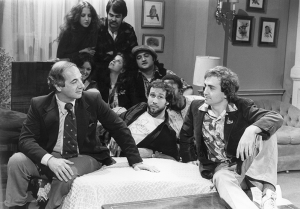12 times 'Saturday Night Live' made a cultural bang over the past 50
years
 Send a link to a friend
Send a link to a friend
 [February 13, 2025]
By MARK KENNEDY [February 13, 2025]
By MARK KENNEDY
NEW YORK (AP) — “Saturday Night Live” was built with a cast of young
no-names performing countercultural comedy. Fifty years later, it is
firmly part of the culture, dictating mainstream comedy instead of
throwing spitballs from the margins.
The show has become an incubator of talent — think Will Ferrell, Chris
Rock, Amy Poehler, Billy Crystal, Julia Louis-Dreyfus, Eddie Murphy,
Adam Sandler, Phil Hartman, Pete Davidson and Tracy Morgan. Its sketches
have sparked Hollywood movies, from “The Blues Brothers” and “Wayne's
World” to “MacGruber” and “Coneheads.”
But “SNL” has embedded itself in our culture in deeper ways, from
slogans like “We're not worthy!” to “You look mahvelous!” It inspires
Halloween costumes, connects viewers to the news via “Weekend Update”
and may even have influenced elections.
As the show gears up to celebrate its milestone, here are 12 moments
over the past five decades when the show didn't just reflect pop culture
— it drove it.
“Wolverines,” 1975
This was the first sketch from the first show, an
absurdist-meets-physical comedy interaction between a student — played
by John Belushi — and his English teacher, played by head writer Michael
O’Donoghue. “I would like to feed your fingertips to the wolverines,”
the teacher asks his pupil to repeat.
The show, then called “NBC's Saturday Night,” would have George Carlin
as the first host. Jim Henson’s Muppets had a sketch and Andy Kaufman
lip-synched the “Mighty Mouse” theme song. Billy Preston played his hit
“Nothing From Nothing” and later folk singer Janis Ian sang “At
Seventeen” and “In the Winter.” Preston closed things out with “Fancy
Lady.”
New York magazine called its promise “enormous” and the Chicago Tribune
said it “premiered in superb fashion.” The Los Angeles Times said it was
“bright and bouncy” and even suggested it move to prime time.

“King Tut,” 1978
Steve Martin saw this off-the-wall novelty song about ancient Egyptian
pharaoh Tutankhamun capture the nation’s imagination during a goofy
performance. It eventually reached No. 17 on the Billboard Hot 100 and
sold over 1 million copies after he performed it on “SNL.”
The comedian was parodying the hysteria and commercialization
surrounding a traveling Tutankhamun exhibit, dancing sideways as he sang
“King Tut/Buried with a donkey/Funky Tut/He’s my favorite honky!”
The song was riddled with errors: King Tut was not “born in Arizona,” he
did not live in a “condo made of stone-a” and he was not “buried in his
jammies.” Nevertheless, the song went viral long before there was an
internet.
“The French Chef,” 1978
Dan Aykroyd parodied iconic chef Julia Child in a cooking segment gone
horribly wrong: She cuts “the dickens” out of her finger, releasing
staggeringly large spurts of blood, tries first aid and then collapses
face-first in a puddle of her own blood.
It was inspired by a real injury on the set of Child's “The French Chef”
and was written by Tom Davis and Al Franken (the future former senator
was also under the table pumping blood out of a tube on Aykroyd’s arm).
Instead of being offended, Child enjoyed Aykroyd’s parody of herself so
much that the book “Baking With Julia” recounts she would play the tape
at her own dinner parties, crying out, “Save the liver!’”
“White Like Me,” 1984
Long before white privilege became a mainstream concept, Eddie Murphy in
a landmark sketch put on white face makeup to see how he would be
treated as a white man in New York.
It was a parody of the famous 1961 book “Black Like Me,” in which a
white journalist went undercover as a Black man. You can see the legacy
in “Chappelle’s Show,” Whoopi Goldberg’s “The Associate” and “White
Chicks.”
In the skit, a cashier won’t take his money for a newspaper (“Slowly, I
began to realize that when white people are alone, they give things to
each other for free”), a city bus turns into a party after the lone
Black passenger gets off and a bank clerk simply hands him $50,000 in
cash. “So what did I learn from all of this?” Murphy asks at the end. “I
learned that we still have a very long way to go in this country before
all men are truly equal.”

Sinéad O’Connor, 1992
The Irish singer capped her a cappella cover of Bob Marley’s “War” by
holding up a photo of Pope John Paul II and tearing it into pieces.
“Fight the real enemy,” she said. “SNL” was blindsided. During
rehearsals, O’Connor had instead held up an image of a refugee child.
She was protesting child sex abuse in the Catholic Church, a decade
before the Boston Globe revealed a systematic cover-up that forced the
church to apologize and pay millions.
NBC banned O’Connor from “SNL” for life, Joe Pesci mocked her during the
next week’s show and Frank Sinatra called her “one stupid broad.” Her
albums were crushed by a steamroller in Times Square. Less than two
weeks later, O’Connor made her first public appearance following the
incident at a Bob Dylan concert at Madison Square Garden and she was
jeered as Kris Kristofferson consoled her.
White House vs. “Wayne's World,” 1993
White House figures are a long-standing target for “SNL.” In 1993, the
White House fired back.
In a “Wayne’s World” sketch, Mike Myers and Dana Carvey’s immature,
basement-dwelling characters suggested first daughter Chelsea Clinton,
then 13, wasn’t as attractive as then-vice president Al Gore’s
daughters.
[to top of second column]
|

White House Press Secretary Ron Nessen, left, appears on the
"Saturday Night Live" set with producer Lorne Michaels, right, and
cast members Chevy Chase, foreground center, Laraine Newman,
background left, Dan Aykroyd, background right, Jane Curtin, second
row from left, Gilda Radner, John Belushi and Garret Morris,
partially obscured, on April 17, 1976, in New York. (AP Photo)
 Hillary Clinton scolded producer
Lorne Michaels and his writers for “having nothing better to do than
be mean and cruel to a young girl.” Michaels issued an apology,
Myers apologized to the Clintons and the joke was cut from
subsequent reruns of the sketch.
“More Cowbell,” 2000
Another wacky skit that permanently entered the culture was when
Christopher Walken, playing a producer as Blue Öyster Cult recorded
“(Don’t Fear) the Reaper,” insisted: “I gotta have more cowbell.”
The sketch — widely regarded as one of the show's greatest —
lampooned the excess of ’70s rock and became a shorthand for adding
one too many layers. The irony is that the idea was submitted some
seven times before finally airing.
Blue Öyster Cult had to ban people from bringing actual cowbells to
their concerts and Walken has said people tease him about cowbells
everywhere he goes. The sketch was so influential that producers of
the four-part “SNL50: Beyond Saturday Night” dedicated an entire
episode to the parody.
First show after 9/11, 2001
Less than three weeks after 9/11, “Saturday Night Live” aired one of
its most memorable openings. Rudy Giuliani, then New York City's
mayor, was flanked by firefighters and police officers who had just
left ground zero.
Calling “Saturday Night Live” one of New York’s greatest
institutions, Giuliani said: “Having our city’s institutions up and
running sends a message that New York City is open for business.”
“Can we be funny?” Michaels asked, to which the mayor responded with
perfect timing, “Why start now?”
That joke told everyone that things could be all right.
Ashlee Simpson, 2004
The younger sister of Jessica Simpson, making her “SNL” musical
debut, first performed her hit “Pieces of Me.” All good. But when
she came back to play the title track from her album
“Autobiography,” the audience heard the vocal track from the first
song by mistake.
Awkwardness ensued. Simpson did a silly shuffle and then walked off
stage as her group continued to play and the show cut to commercial.
She later said a case of acid reflux forced her to lip-sync that
night.
The incident drew attention to one of pop culture’s worst-kept
secrets: Lip-syncing was way more common than performers or the
music industry wanted us to think. Billboard magazine ranked it
second among lip-sync scandals in modern pop history — after Milli
Vanilli.

“Lazy Sunday,” 2005
“SNL” is live, of course, but sometimes the funniest bits are
pretaped, like the digital shorts from Andy Samberg and his Lonely
Island compatriots, Jorma Taccone and Akiva Schaffer. They crafted
101 digital shorts between 2005 and 2012 — many of them destined for
virality, from “Dick in a Box,” with Justin Timberlake, to
“Natalie's Rap” with Natalie Portman and “Shy Ronnie” with Rihanna.
“Lazy Sunday” was the second video “SNL” viewers got from the trio,
starring Samberg and Chris Parnell rapping about hilariously mundane
yuppie activities, like grabbing cupcakes and using Google Maps. It
inspired an entire genre of video-shot joke raps and fed a
fast-growing site that people had only just become aware of —
YouTube.
“Lazy Sunday” was the first TV show clip to have a viral second life
online, with 2 million-plus viewings in its first week alone. That
week, YouTube’s traffic was up 83%.
Tina Fey does Sarah Palin, 2008
Many people believe that Republican vice-presidential candidate
Palin once uttered: “I can see Russia from my house.” She never said
that. That was Fey in her first appearance as Palin on “SNL.”
Fey’s spot-on impression — later leaning into the more ridiculous
sayings the candidate had offered — may have changed some minds and
therefore influenced the presidential election, an amazing thing for
a comedy show. CNN coined the phrase the “Tina Fey Effect.”
People actually did studies on the “Tina Fey Effect” after the 2008
election and found Republican and independent voters liked Palin
less after watching the “SNL” rendition of the politician, even
though Palin herself appeared on the show alongside Fey to show she
was in on the joke.
“Welcome to Hell,” 2017
“SNL” addressed the #MeToo movement with a pitch-perfect video — a
bubblegum song with lyrics about how women have suffered abuse and
harassment for centuries.
Guest host Saoirse Ronan was joined by cast members Melissa
Villaseñor, Leslie Jones, Aidy Bryant, Kate McKinnon and Cecily
Strong, many of whom had teamed up for hysterical pop girl group
songs like “First Got Horny 2 U,”“Back Home Ballers,” and “(Do It on
My) Twin Bed.”
This time, the comedy was bleak: “Now ‘House of Cards’ is ruined,”
goes the song, “and that really sucks. Well, here’s a list of stuff
that’s ruined for us: parking, and walking, and Uber, and ponytails,
and bathrobes, and nighttime, and drinking, and hotels, and vans.”
All contents © copyright 2025 Associated Press. All rights reserved |